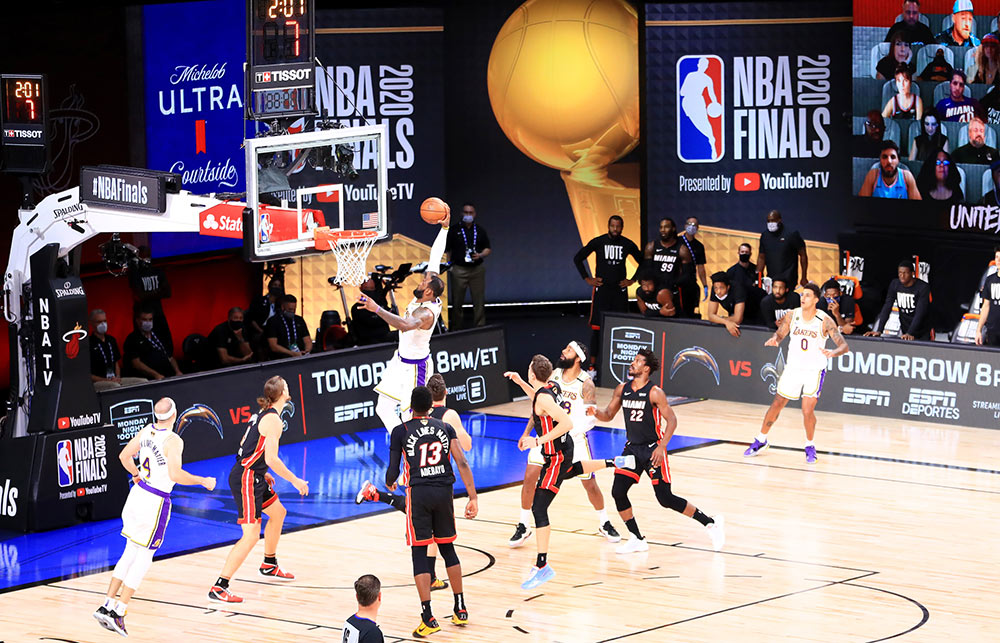
对NBA来说,过去这一年十分艰难。
下坡路始于去年秋天:NBA的前任总裁、也是带领该联盟走向辉煌的传奇经理人大卫•斯特恩在元旦意外去世。仅仅几个星期后,退役的湖人巨星科比•布莱恩特和他13岁的女儿在一场直升机坠毁事故中去世,更是震惊了整个世界。
然后,就在全明星周末赛后一个月、犹他爵士队和俄克拉荷马城雷霆队即将展开角逐之前,比赛被推迟了:一名爵士队员检测出新冠病毒呈阳性。很快,整个联盟都关闭了。
“如果说2019-2020赛季的前半段,NBA遭遇的只是平流中的大风浪,那么新冠疫情就是把它送到了瀑布关头。”赖辛基在本周的Reinvent播客节目中说道,感慨在疫情使世界天翻地覆的时候,人们要如何挣扎着求生。
本周的节目将带领听众们走近赖辛基最近发布的专题故事,该故事由《财富》杂志副编辑布莱恩•奥基夫撰写,内容涉及NBA的“隔离泡”——即该联盟为球员创建的一个处在保护之下的隔离环境,以确保他们能够安全地结束这个赛季。
NBA的“隔离泡”是如何起作用的——这不只是一个体育方面的话题,也是领导力和业务运营方面的重要一课。赖辛基在这集节目中说:“ NBA告诉我们,人们首先要关注自己的产品,就NBA而言,它的产品就是篮球比赛。” “这意味着要与球员们保持良好的关系,倾听他们的顾虑,在执行政策的时候要灵活变通,并根据具体情况调试,尽一切可能维持业务的发展——此外,如果要保证业务运行顺畅、品牌完整,还要投入大笔资金。”
赖辛基向我们讲述,他们是如何把奥兰多迪士尼乐园打造成NBA“隔离泡”这一受保护的环境,并解决了300名成年男性、团队工作人员、联赛官员和媒体可以在其中安全共事的问题。
赖辛基解释说:“如果美国其他地方的防疫措施都能够做得像NBA一样好,哪怕只是达到其中一小部分成就,那么疫情的走向都可能会有所不同。”
NBA使用了许多高科技工具来进行疫情防控,诸如实时地理位置技术公司Kinexon提供的一项技术,可以跟踪运动员的活动来监测社交距离。它也采用了一些非技术手段来进行疫情防控,例如禁止球员舔手指、随地吐痰、擤鼻子或触摸护齿器。
总体而言,NBA花了1.8亿美元用于“隔离泡”相关的开支,而这也取得了巨大的成效——在奥兰多迪士尼乐园里,包括球员、教练在内的所有人,没有一个感染。疫情之下,NBA面临着约15亿美元的损失,而如果他们无法举行这些比赛,这个数字将会高得多。
赖辛基说:“他们之所以这样做,是为了表明他们不仅可以应对这场危机,还能够表现得十分出色——这对NBA这个品牌来说,具有相当积极的意义。”(财富中文网)
编译:陈聪聪
对NBA来说,过去这一年十分艰难。
下坡路始于去年秋天:NBA的前任总裁、也是带领该联盟走向辉煌的传奇经理人大卫•斯特恩在元旦意外去世。仅仅几个星期后,退役的湖人巨星科比•布莱恩特和他13岁的女儿在一场直升机坠毁事故中去世,更是震惊了整个世界。
然后,就在全明星周末赛后一个月、犹他爵士队和俄克拉荷马城雷霆队即将展开角逐之前,比赛被推迟了:一名爵士队员检测出新冠病毒呈阳性。很快,整个联盟都关闭了。
“如果说2019-2020赛季的前半段,NBA遭遇的只是平流中的大风浪,那么新冠疫情就是把它送到了瀑布关头。”赖辛基在本周的Reinvent播客节目中说道,感慨在疫情使世界天翻地覆的时候,人们要如何挣扎着求生。
本周的节目将带领听众们走近赖辛基最近发布的专题故事,该故事由《财富》杂志副编辑布莱恩•奥基夫撰写,内容涉及NBA的“隔离泡”——即该联盟为球员创建的一个处在保护之下的隔离环境,以确保他们能够安全地结束这个赛季。
NBA的“隔离泡”是如何起作用的——这不只是一个体育方面的话题,也是领导力和业务运营方面的重要一课。赖辛基在这集节目中说:“ NBA告诉我们,人们首先要关注自己的产品,就NBA而言,它的产品就是篮球比赛。” “这意味着要与球员们保持良好的关系,倾听他们的顾虑,在执行政策的时候要灵活变通,并根据具体情况调试,尽一切可能维持业务的发展——此外,如果要保证业务运行顺畅、品牌完整,还要投入大笔资金。”
赖辛基向我们讲述,他们是如何把奥兰多迪士尼乐园打造成NBA“隔离泡”这一受保护的环境,并解决了300名成年男性、团队工作人员、联赛官员和媒体可以在其中安全共事的问题。
赖辛基解释说:“如果美国其他地方的防疫措施都能够做得像NBA一样好,哪怕只是达到其中一小部分成就,那么疫情的走向都可能会有所不同。”
NBA使用了许多高科技工具来进行疫情防控,诸如实时地理位置技术公司Kinexon提供的一项技术,可以跟踪运动员的活动来监测社交距离。它也采用了一些非技术手段来进行疫情防控,例如禁止球员舔手指、随地吐痰、擤鼻子或触摸护齿器。
总体而言,NBA花了1.8亿美元用于“隔离泡”相关的开支,而这也取得了巨大的成效——在奥兰多迪士尼乐园里,包括球员、教练在内的所有人,没有一个感染。疫情之下,NBA面临着约15亿美元的损失,而如果他们无法举行这些比赛,这个数字将会高得多。
赖辛基说:“他们之所以这样做,是为了表明他们不仅可以应对这场危机,还能够表现得十分出色——这对NBA这个品牌来说,具有相当积极的意义。”(财富中文网)
编译:陈聪聪
It had already been a tough year for the NBA.
It started last fall when the general manager of the Houston Rockets sent out a tweet that was sympathetic to the protestors in Hong Kong, which got the NBA taken off of broadcast television in China and cost the league millions. Then David Stern, the legendary former NBA commissioner, died unexpectedly on New Year’s Day. Just a few weeks later, the death of retired Laker superstar Kobe Bryant and his 13-year-old daughter in a helicopter crash rocked the world.
Then one month after the All-Star weekend, just before the Utah Jazz and Oklahoma City Thunder were about to tip off, the game was postponed. A Jazz player had tested positive for COVID. Soon, the entire league shut down.
“If the NBA had spent the first part of the 2019-2020 season swimming through some big rapids, COVID just sent it over the waterfall,” says Adam Lashinsky in this week’s episode of Reinvent, a podcast about fighting to thrive in a world turned upside down by COVID-19.
This week’s episode takes listeners inside Lashinsky’s recently published feature story, written with Fortune deputy editor, Brian O’Keefe, about the NBA bubble—the protected environment the league created to keep players safe in order to finish out its season.
How the NBA bubble came to be is far more than a sports story; it’s also a lesson in leadership and business. “The NBA taught us that you pay attention to your product first and foremost, and in the NBA’s case, its product is the game of basketball,” Lashinsky says during the episode. “That means having a good relationship with its players, listening to the their concerns, being flexible and adaptable, and doing everything you can to stay in business—including, by the way, spending a whole bunch of money if that’s what it takes to get it done and keep the brand intact.”
Lashinsky breaks down how the bubble worked with 300 grown men, the team staffs, league officials, and the media all in this protected environment on a campus at Disney World in Orlando.
“If the rest of the country had even done a fraction of what the NBA had done, the virus might have taken a different course,” Lashinsky explains.
The NBA used high-tech tools like technology from Kinexon, a real-time geolocation technology company, that tracks athletes’ performance to monitor social distancing. It also embraced low-tech solutions like discouraging players from licking their fingers, spitting, clearing their noses, or touching their mouth guards.
In all, the NBA spent $180 million dollars on bubble-related expenses that resulted in not a single positive test of a player, coach, or any of the people living on the campus in Orlando. The NBA faced a revenue shortfall of $1.5 billion associated with the pandemic, but that number would have been much higher if they hadn’t been able to play those games.
“They came out of this having shown that they could respond to a crisis, and still do pretty darn well," Lashinsky says, "which is pretty good for the brand of the NBA."






